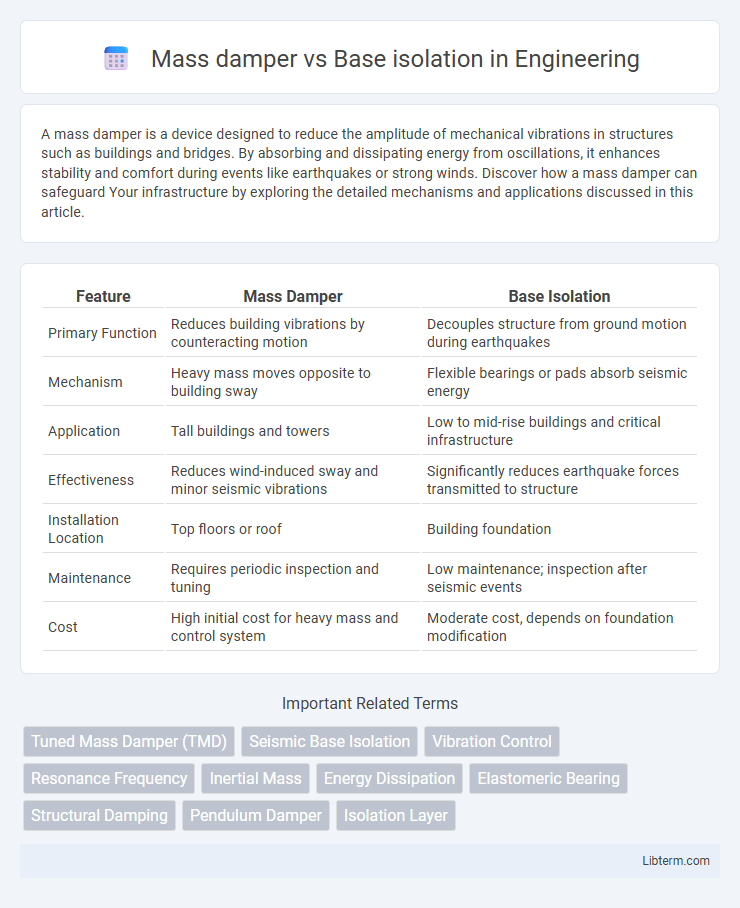A mass damper is a device designed to reduce the amplitude of mechanical vibrations in structures such as buildings and bridges. By absorbing and dissipating energy from oscillations, it enhances stability and comfort during events like earthquakes or strong winds. Discover how a mass damper can safeguard Your infrastructure by exploring the detailed mechanisms and applications discussed in this article.
Table of Comparison
| Feature | Mass Damper | Base Isolation |
|---|---|---|
| Primary Function | Reduces building vibrations by counteracting motion | Decouples structure from ground motion during earthquakes |
| Mechanism | Heavy mass moves opposite to building sway | Flexible bearings or pads absorb seismic energy |
| Application | Tall buildings and towers | Low to mid-rise buildings and critical infrastructure |
| Effectiveness | Reduces wind-induced sway and minor seismic vibrations | Significantly reduces earthquake forces transmitted to structure |
| Installation Location | Top floors or roof | Building foundation |
| Maintenance | Requires periodic inspection and tuning | Low maintenance; inspection after seismic events |
| Cost | High initial cost for heavy mass and control system | Moderate cost, depends on foundation modification |
Introduction to Seismic Protection Systems
Seismic protection systems such as mass dampers and base isolation aim to reduce structural damage during earthquakes by mitigating vibrations and ground motion effects. Mass dampers use a heavy mass to counteract building sway through inertia, effectively reducing oscillations in tall structures. Base isolation involves installing flexible bearings or pads between the foundation and superstructure, decoupling the building from ground movement and minimizing seismic forces transmitted to the structure.
What is a Mass Damper?
A mass damper is a device designed to reduce the amplitude of mechanical vibrations in structures by using a secondary mass attached to the primary structure, effectively dissipating energy through oscillations. Commonly implemented in skyscrapers and bridges, mass dampers help mitigate sway and enhance stability during seismic activities and wind loads. This technology contrasts with base isolation, which separates the building from ground motion, while mass dampers actively counteract movements within the structure itself.
Understanding Base Isolation Technology
Base isolation technology employs flexible bearings or isolators, such as laminated rubber bearings or sliding bearings, positioned between a building's foundation and superstructure to decouple seismic energy and reduce structural acceleration during earthquakes. Unlike mass dampers that rely on tuned masses to counteract building sway, base isolators absorb and dissipate seismic forces by allowing controlled horizontal movement, effectively minimizing damage. This method is widely used in critical infrastructure like hospitals and bridges to enhance earthquake resilience and maintain operational continuity.
Key Differences Between Mass Dampers and Base Isolation
Mass dampers reduce building sway by adding a heavy mass that moves opposite to the structure's motion, effectively absorbing vibrations during events like earthquakes or wind. Base isolation involves installing flexible bearings or isolators between a building's foundation and superstructure, allowing the structure to move independently of ground motion and minimizing seismic forces transmitted. Key differences include mass dampers' reliance on dynamic counter-mass movement for vibration control, whereas base isolation physically decouples the structure from ground shaking to prevent damage.
Mechanisms of Vibration Control
Mass dampers control vibrations by utilizing a secondary mass attached to the structure, which moves out of phase with the building's oscillations to counteract seismic forces. Base isolation involves installing flexible bearings or pads between a building's foundation and superstructure, effectively decoupling the structure from ground motion and reducing transmitted vibrations. Both mechanisms enhance structural resilience during earthquakes, with mass dampers primarily dissipating kinetic energy and base isolation minimizing seismic acceleration input.
Performance in Earthquake Scenarios
Mass dampers effectively reduce building vibrations by counteracting seismic forces through a tuned mass system, enhancing structural stability during earthquakes. Base isolation systems improve performance by decoupling the building from ground motion, significantly reducing the acceleration transmitted to the structure. Both techniques optimize earthquake resilience, but base isolation offers superior reduction in seismic energy transfer, while mass dampers excel in controlling sway in taller, flexible buildings.
Benefits and Limitations of Mass Dampers
Mass dampers effectively reduce structural vibrations by absorbing and dissipating kinetic energy, improving building stability during wind or seismic events. They offer precise tuning to target specific frequencies but require careful design and regular maintenance, sometimes adding significant weight to the structure. Limitations include high initial costs and reduced efficiency if the damper is not calibrated properly for varying dynamic forces.
Advantages and Drawbacks of Base Isolation
Base isolation significantly reduces seismic forces transmitted to a structure by decoupling it from ground motion, enhancing occupant safety and minimizing structural damage during earthquakes. Its advantages include simplicity in retrofit applications and compatibility with various building types, while drawbacks involve potential high initial costs and limited effectiveness against long-period seismic waves. Maintenance and inspection are crucial to ensure isolator performance, as deterioration over time can reduce seismic protection.
Cost and Installation Considerations
Mass dampers typically incur higher upfront costs due to complex design and heavy materials, requiring precise engineering and structural integration during installation. Base isolation systems often present moderate initial expenses but demand significant foundation modifications, extending installation time and labor. Both solutions necessitate professional assessment to balance budget constraints with seismic performance goals effectively.
Choosing the Right System for Structural Safety
Mass dampers effectively reduce building sway during wind and seismic events by counteracting motion through a large suspended mass, making them ideal for tall structures with flexible frames. Base isolation systems minimize seismic forces transmitted to a building by decoupling the structure from ground motion via isolators, providing superior protection for low- to mid-rise buildings in high seismic zones. Selecting the right system depends on building height, structural flexibility, and site seismicity to optimize structural safety and performance.
Mass damper Infographic

 libterm.com
libterm.com